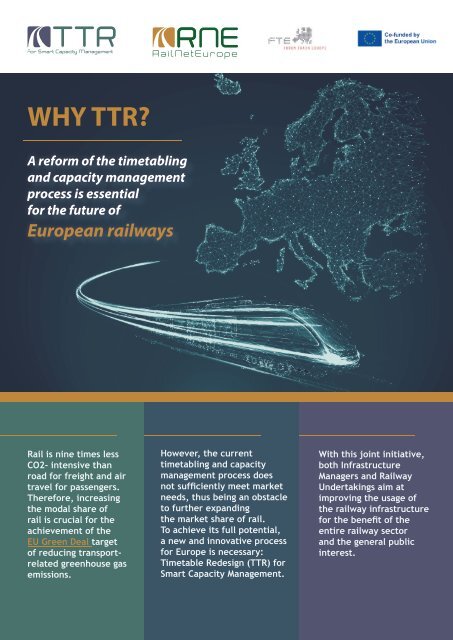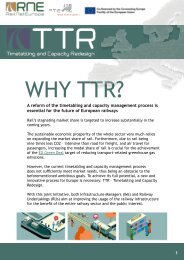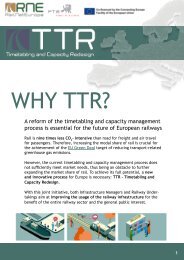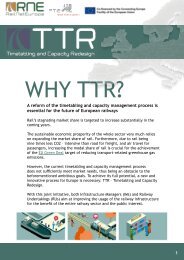TTR_Extended_Brochure_2023
Create successful ePaper yourself
Turn your PDF publications into a flip-book with our unique Google optimized e-Paper software.
WHY <strong>TTR</strong>?<br />
A reform of the timetabling<br />
and capacity management<br />
process is essential<br />
for the future of<br />
European railways<br />
Rail is nine times less<br />
CO2- intensive than<br />
road for freight and air<br />
travel for passengers.<br />
Therefore, increasing<br />
the modal share of<br />
rail is crucial for the<br />
achievement of the<br />
EU Green Deal target<br />
of reducing transportrelated<br />
greenhouse gas<br />
emissions.<br />
However, the current<br />
timetabling and capacity<br />
management process does<br />
not sufficiently meet market<br />
needs, thus being an obstacle<br />
to further expanding<br />
the market share of rail.<br />
To achieve its full potential,<br />
a new and innovative process<br />
for Europe is necessary:<br />
Timetable Redesign (<strong>TTR</strong>) for<br />
Smart Capacity Management.<br />
With this joint initiative,<br />
both Infrastructure<br />
Managers and Railway<br />
Undertakings aim at<br />
improving the usage of<br />
the railway infrastructure<br />
for the benefit of the<br />
entire railway sector<br />
and the general public<br />
interest.
The Shortcomings of the<br />
Current Timetabling and<br />
Capacity Management...<br />
Temporary Capacity Restrictions (TCRs) are inevitable – but require better<br />
planning, communication and harmonisation in order to not be a major<br />
obstacle to a competitive rail sector. Today, TCRs lead to unexpected costs,<br />
even loss of business for RUs, reduced reliability towards the market and<br />
unnecessary unavailability of lines.<br />
With the final timetable being published in September, passenger RUs cannot<br />
sell their tickets well in advance of the timetable change in December –<br />
adding competitive disadvantage in relation to road and air<br />
The current timetabling process focusses strongly on annual requests. This<br />
early placement of path requests is lacking the dynamic and agility some<br />
businesses, especially rail freight, need to remain competitive, eventually<br />
leading to redundant bookings, high cost and loss of capacity.<br />
International path harmonisation is often impeded by national processes and<br />
behaviours that are not aligned internationally.<br />
Prerequisite for internationally harmonised timetabling processes is a high<br />
degree of synchronised digitalisation and corresponding national IT systems.<br />
Too often, this is not yet the case. Also, stronger attention to fast, digitalised<br />
ad hoc request handling is rightfully demanded.
… And How <strong>TTR</strong> Will<br />
Overcome Them<br />
With the Capacity Strategy and a Capacity Model, IMs allocate capacity to<br />
various needs (freight, passengers, TCRs) from the beginning. These deliverables<br />
contribute to safeguarding commercial capacity of good quality,<br />
in particular for long distance traffic. On top of that, with improved RU<br />
consultation, the needed clustering of TCRs by their impact, and last but not<br />
least, the TCR Tool for optimised communication and planning, <strong>TTR</strong> provides<br />
solutions for an internationally coordinated approach to minimise negative<br />
impacts.<br />
Through advanced planning with Capacity Models, leading to an acceleration<br />
of the allocation process, passenger RUs can sell their tickets several months<br />
in advance, thus becoming more competitive.<br />
Differentiated timetabling products – several of which will build on<br />
safeguarded capacity – will serve the diverse market needs: annual timetable<br />
requests will be complemented by possibilities to request capacities shortly<br />
before the train run through high-quality, nationally and internationally<br />
harmonised capacity products.<br />
<strong>TTR</strong> stands for the Europe-wide and cross-border harmonisation of all<br />
relevant timetabling processes to facilitate international rail traffic and<br />
make work easier for both Infrastructure Managers and Railway Undertakings.<br />
Specif-ically, a common IT infrastructure and the adaptation of a <strong>TTR</strong>supportive<br />
legal framework will be key.<br />
Digital Capacity Management (DCM) as integral IT-part of <strong>TTR</strong> will connect a<br />
multitude of national IT systems to a central business layer, thus ensuring<br />
compatibility. It will allow quick communication and enable easier<br />
amendments – no matter the type of traffic, domestic or international,<br />
passenger or freight.<br />
Digitilsation of national and international layers will minimise manual work<br />
load and lead times in capacity planning and path allocation. It will assist in<br />
optimisation and will benefit both RUs and IMs.
KEY <strong>TTR</strong> ELEMENTS<br />
As outlined on the following pages in more detail, the success of <strong>TTR</strong><br />
and its timely rollout will very much depend on the composition of five<br />
key elements, which constitute the core of the programme.<br />
Only the synchronised orchestration of<br />
• revising outdated timetabling processes<br />
• setting up a process-supporting Digital Capacity Management<br />
• implementing process-supporting commercial conditions<br />
• giving input to legislative bodies to eliminate obstacles,<br />
which endanger full implementation<br />
• coordinating all involved stakeholders in their transition from<br />
testing to implementation<br />
will ensure that <strong>TTR</strong> can achieve its full potential.<br />
Revised<br />
Process<br />
Key <strong>TTR</strong><br />
Elemnts<br />
DCM<br />
Legal<br />
Framework<br />
Implementation<br />
Commercial<br />
Conditions
REVISED PROCESS<br />
The revised timetabling and capacity management process builds on new a<br />
nd innovative components. It reaches from early strategic planning to<br />
short-notice capacity requests and focuses on efficient international<br />
coordination to best balance the different rail capacity needs.<br />
Three years before the timetable change, the Capacity Strategy is decided upon, including the input<br />
from all stakeholders. It feeds into the Capacity Model together with the Capacity Needs Announcements<br />
from applicants, and the IMs’ experience. In the Capacity Model, the capacity will be partitioned<br />
according to the market needs, already including capacity being required by TCRs.<br />
Starting eleven months before the timetable change, the Capacity Supply will be published which is<br />
expressed in capacity products: Annual Requests offer the possibility of early booking and early response,<br />
Rolling Planning and Short-term Requests will meet the market’s demand for more flexibility.<br />
With all components implemented, the entire rail sector will benefit<br />
Freight RUs can request shortly before the train run, knowing all path details and being assured to receive<br />
high-quality paths<br />
Passenger RUs will have earlier stable paths and thus can open their booking system six months prior to<br />
the timetable change<br />
IMs can stabilise their plans, reduce redundancies in the timetabling process, make better use of the<br />
available infrastructure capacity and provide harmonised highquality offers<br />
All Stakeholders will benefit from increased efficiency through the reduction of peak loads<br />
Legal Framework &Network Statements<br />
Comercial Conditions<br />
TCR Managment<br />
Capacity<br />
Strategy<br />
Capacity<br />
Model<br />
Capacity<br />
Planning<br />
Annual<br />
Request<br />
Rolling<br />
Planning<br />
Short<br />
Term Request<br />
Digital Capacity Managment (DCM)
DIGITAL CAPACITY<br />
MANAGEMENT<br />
The goal of implementing a revised process and achieving efficient<br />
communication at European level among all stakeholders can only<br />
be reached through synchronised digitalisation and the joint usage<br />
of dedicated IT systems that are specifically designed and customised<br />
to the <strong>TTR</strong> process.<br />
Digital Capacity Management aims to<br />
• increase the quality of information exchanged between all stakeholders,<br />
• accelerate process steps by allowing for a certain extent of automation and optimisation<br />
• provide easy access to all stakeholders, either via interfaces or via web browsers.<br />
DCM consists of two main blocks: the central IT framework developed by RNE and national<br />
and external systems, which will communicate with the central IT framework.<br />
The communication will be based on TAF/TAP TSI standards.<br />
Several important functions for applicants and IMs (like capacity needs announcmenents,<br />
pre-planning, TCRs, capacity models, capacity supplies, path requests and path handling) will be<br />
combined in one common IT eco-system.<br />
External systems<br />
Data Exchange Layer<br />
(TAF/TAP TSI Comliant messaging) g)<br />
IT Framework<br />
r<br />
Applicant<br />
systems<br />
Messaging<br />
Module<br />
Applicant<br />
plica<br />
Layer<br />
Big Data<br />
Layer<br />
Layer<br />
Messaging<br />
sa<br />
Module<br />
IM’s<br />
System<br />
(<strong>Extended</strong> Common mon interface)
COMMERCIAL<br />
CONDITIONS<br />
To encourage stakeholders<br />
to use the process and capacity<br />
products as efficiently as possible,<br />
certain commercial conditions<br />
must be agreed and applied to<br />
avoid loss of capacity and ensure<br />
consistency across borders<br />
at European level.<br />
P<br />
PA<br />
PA<br />
P<br />
ATH MODIFICAT<br />
A<br />
ION<br />
L<br />
ATH ALT<br />
A<br />
ERAT<br />
ION<br />
CA<br />
C<br />
HARMONIZED<br />
COMMERCIAL<br />
CONDITIONS<br />
NCELLA<br />
L<br />
ATION (IM)<br />
CANCELLAT<br />
(APPLICANT)<br />
A<br />
NON- USAGE OF PA<br />
ION<br />
ATH<br />
P<br />
Rail capacity is wasted, mainly due to<br />
• capacity blocked but eventually not used by RU stakeholders<br />
• constantly changing planning parameters (both RU and IM)<br />
Commercial Conditions shall steer the behaviour of stakeholders towards making<br />
the best use of available capacity on the rail network.<br />
The following process elements require steering through commercial conditions:<br />
Path modification,<br />
cancellation and non-usage<br />
by Applicant<br />
due to commercial or operational<br />
needs<br />
Path alteration<br />
and cancellation by IM<br />
in connection with TCRs<br />
(late TCRs, changes in planned TCRs)<br />
Commercial Conditions are part of the focused projects to find consensus<br />
among IMs and RUs.
LEGAL<br />
FRAMEWORK<br />
Due to its innovative nature, <strong>TTR</strong> is not fully compatible with existing EU and<br />
national legal frameworks reflecting current, outdated processes. Overcoming<br />
legal obstacles is a prerequisite for successful <strong>TTR</strong> implementation.<br />
While a number of innovative <strong>TTR</strong><br />
components, such as the capacity<br />
strategy, are currently largely<br />
unregulated or in line with existing<br />
legislation, aspects such as the<br />
Rolling Planning concept, the<br />
multi-annual aspect or the capacity<br />
partitioning are surrounded by<br />
a high degree of legal uncertainty.<br />
Particularities of national legal<br />
frameworks and Regulatory Bodies’<br />
decision-making practice have also<br />
been identified as potential obstacles<br />
to a harmonised implementation<br />
of <strong>TTR</strong>.<br />
EU<br />
LAW<br />
NATIONAL<br />
LAWS<br />
<strong>TTR</strong><br />
NS CID*<br />
* Network Statements &<br />
Corridor Information Documents<br />
Joint efforts of the sector and decision-makers<br />
and a mix of measures will be needed to overcome<br />
these obstacles and provide a solid legal<br />
basis for <strong>TTR</strong> rollout. This will involve, among<br />
others, amendments to legislation where indispensable,<br />
and convergence towards a common<br />
understanding of existing law open to <strong>TTR</strong><br />
wherever possible.<br />
The sector has made available an in-depth<br />
analysis of potential legal obstacles to <strong>TTR</strong><br />
implementation stemming from EU law and<br />
national legal frameworks (‘<strong>TTR</strong> Obstacles roadmap’).<br />
The European Commission, in support of<br />
<strong>TTR</strong>, published an innovative draft legal proposal<br />
for a Capacity Management Regulation in July<br />
<strong>2023</strong>.
IMPLEMENTATION<br />
Implementation of the re-designed process and all its components is finally<br />
the most important step, in which the commitment and efforts of all players<br />
will be key to the success of the programme. Process components and IT<br />
systems are already being rolled out and overall implementation<br />
is spearheaded by a group of ‘First Wave Implementers’, IMs who will be<br />
front-runners, paving the way for the re-designed approach.<br />
While all members of RNE have committed to implementing<br />
<strong>TTR</strong>, some countries experience a more<br />
pressing need to implement parts of <strong>TTR</strong> ahead of<br />
schedule to meet market requirements. They represent<br />
the first wave of <strong>TTR</strong> implementers and accelerate<br />
implementation through earlier and increased<br />
investments.<br />
First Wave<br />
Implementers<br />
Other RNE<br />
Members<br />
Others<br />
Based on the <strong>TTR</strong> Migration Concept,<br />
the first implementations have started on<br />
a reduced geographical scope to have early<br />
learnings. The first capacity strategies<br />
are already available for timetable periods<br />
2025 and 2026 and the first capacity models<br />
for timetable period 2025 were piloted<br />
via a new tool, the European Capacity<br />
Management Tool (ECMT).<br />
Synchronising the aforementioned<br />
<strong>TTR</strong> elements, financing and further<br />
framework parameters will require<br />
a well-orchestrated programme.<br />
RNE will take the coordinating lead<br />
and welcomes the many stakeholders<br />
from all parts of the rail<br />
sector to join forces and support<br />
the <strong>TTR</strong> implementation with a high<br />
level of dedication - for the greater<br />
good of the European rail sector<br />
and beyond.
MORE INFORMATION ON <strong>TTR</strong><br />
For more detailed information<br />
on the <strong>TTR</strong> Programme,<br />
please visit the <strong>TTR</strong> website<br />
Visit website<br />
Or contact us at<br />
ttr@rne.eu<br />
RailNetEurope<br />
Jakov-Lind-Straße 5<br />
1020 Vienna<br />
Austria<br />
Forum Train Europe<br />
Hilfikerstrasse 3<br />
3000 Bern 65<br />
Switzerland<br />
www.rne.eu<br />
www.forumtraineurope.eu<br />
ttr@rne.eu<br />
info@forumtraineurope.eu








